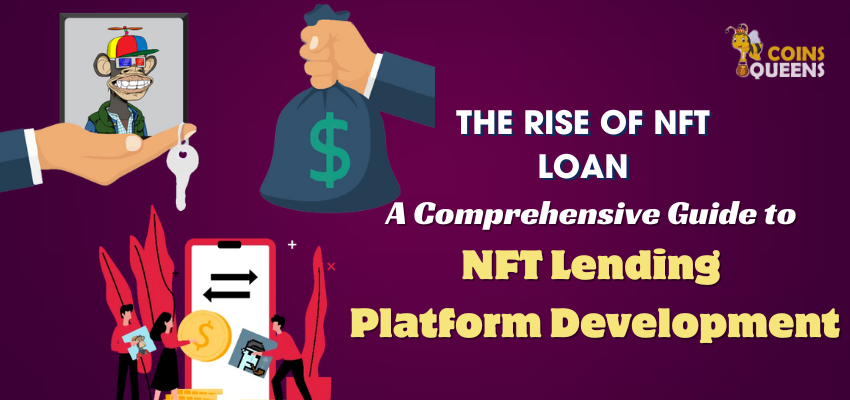Non-fungible tokens (NFTs) have disrupted the digital landscape, transforming how we perceive and trade digital assets. This transformation has extended to the world of finance with the emergence of NFT loans. In this blog, we provide an extensive guide to NFT lending platform development, offering a clear understanding of NFT loans and their growing importance.
We’ll simplify the technicalities, covering the steps involved in creating your NFT lending platform. Our journey will explore the potential and opportunities within this rapidly evolving space, shedding light on a financial realm where digital uniqueness is the key to unlocking new possibilities.
What is NFT Lending?
NFT lending is like a digital item exchange. Imagine lending a unique digital art piece to a friend for a fee. NFT lending platforms work similarly. You can lend your rare digital items to others and earn a fee in return. Or, you can borrow digital assets you need by agreeing to repay with interest. Smart contracts, which are like digital agreements, ensure the process is secure and transparent. NFT lending platforms are designed to add liquidity to your NFT assets, making them more valuable and useful in the cryptocurrency space.
NFT Lending vs Traditional Loans: Key Differences
1. Collateral Types:
- Traditional Loans: Typically require physical assets like real estate, vehicles, or personal guarantees.
- NFT Lending: Allows borrowers to use digital assets, specifically NFTs, as collateral.
2. Credit Checks:
- Traditional Loans: Involve extensive credit checks and documentation to assess the borrower’s creditworthiness.
- NFT Lending: Often doesn’t require traditional credit checks, relying more on the inherent value of the NFT collateral.
3. Interest Rates:
- Traditional Loans: Interest rates are set by financial institutions and can vary based on credit scores.
- NFT Lending: Usually features fixed interest rates determined by smart contracts.
4. Liquidity:
- Traditional Loans: Typically require borrowers to sell assets to access cash, potentially giving up ownership.
- NFT Lending: Offers a way to access funds without relinquishing ownership of valuable NFT assets.
5. Speed and Accessibility:
- Traditional Loans: Involve a complex and often time-consuming application process.
- NFT Lending: Leverages blockchain and smart contracts for a quicker, more accessible loan process.
6. Ownership:
- Traditional Loans: Borrowers maintain ownership of their collateral throughout the loan.
- NFT Lending: Borrowers temporarily transfer NFT ownership as collateral, regaining it upon loan repayment.
Understanding these distinctions is essential when choosing between NFT lending and traditional loans, as they cater to different financial requirements and circumstances.
NFT Lending Types
1. Single Asset Loans: This is like lending your NFT for a specific cryptocurrency amount. It’s a straightforward exchange, and you get your NFT back when the loan is repaid.
2. Portfolio Loans: Think of this as a bundle deal. You can offer multiple NFTs as collateral for a loan, providing flexibility for borrowers and lenders.
3. Fractionalized NFT Loans: It’s akin to sharing ownership of your NFT. Multiple people can own a piece of your NFT, which opens doors for collective lending and shared profits.
4. Overcollateralized Loans: Borrowers provide more collateral than the loan amount, reducing risks for lenders.
5. Cross-Chain NFT Loans: This extends NFT lending across different blockchain networks, expanding the lending ecosystem.
Each lending type has its purpose, catering to various needs within the NFT lending space. Understanding these categories will help you navigate the world of NFT lending more effectively.
NFT Lending Platform Development Benefits
NFT lending platforms offer a basket of advantages, simplifying and expanding opportunities in the world of NFTs. Here, we’ll break down the benefits in straightforward terms:
1. Unlock Liquidity: NFT lending platforms allow you to access cash while keeping your precious digital assets.
2. Earn Passive Income: If you very own treasured NFTs, you could lend them and earn a charge, similar to renting out a room in your house.
3. Diversification: You can diversify your crypto portfolio by investing in NFT loans and earning returns on your investments.
4. Lower Risk: With collateralized loans and smart contracts, NFT lending reduces risks for both lenders and borrowers.
5. Simplified Transactions: NFT lending platforms streamline the lending process, making it easy for everyone, even if you’re new to the crypto world.
6. Market Expansion: These systems open up new markets for NFT buying and selling, giving artists and creditors broader access to the value of their digital property.
NFT lending platforms provide an efficient and secure way to unlock the potential of your NFTs, whether you’re an artist, collector, or investor.
Features of NFT Lending Platform Development
NFT lending platform development brings exciting features that make using these platforms a breeze. Let’s break them down in straightforward terms:
1. User-Friendly Interface: NFT lending platforms are designed for ease of use. It’s like having a simple app on your phone where you can easily manage your digital assets.
2. Smart Contracts: Think of these as digital agreements. They ensure that when you lend or borrow an NFT, everything happens automatically without the need for a middleman.
3. Blockchain Security: Your NFTs are stored on a secure blockchain, like digital vaults, keeping them safe.
4. DeFi Integration: These platforms are often part of the Decentralized Finance (DeFi) ecosystem, offering more financial options.
5. Lending and Borrowing Pools: These are like digital lending markets, making it easy to find suitable lending or borrowing opportunities.
NFT lending platform development simplifies NFT lending by providing a user-friendly, secure, and automated environment, creating new possibilities in the digital asset landscape.
Future Trends For NFT Lending Platform Development
In the Future NFT lending platform development, holds promise and innovation. As more industries recognize the value of NFTs as collateral, lending opportunities will expand to encompass diverse assets, from music to virtual real estate.
Clearer regulations will enhance safety and security, while improved interoperability will make it easier for NFTs to move across various blockchain networks. Smart contracts are set to become more advanced, automating complex lending agreements and calculations.
NFT holders might find new opportunities for earning rewards through staking their assets within lending platforms. Furthermore, decentralized governance and community-driven decisions will play a greater role in shaping the landscape of NFT lending.
These trends aim to make NFTs more versatile, secure, and accessible for everyone involved.
Future Awaits
The rise of NFT loans and the development of lending platforms present an exciting frontier in the digital world. NFT lending simplifies access to capital while retaining ownership of valuable digital assets.
These platforms, with their user-friendly interfaces and smart contracts, offer secure and automated lending solutions. As NFTs continue to gain acceptance, the future holds even more potential for this evolving ecosystem.
With broader adoption, improved regulations, and increased community involvement, NFT lending promises to be a pivotal part of the digital asset landscape, making unique digital items more valuable and versatile than ever.
If you’re considering launching into NFT lending platform development,
Look no further.
CoinsQueens, a pioneer in NFT lending platform solutions, is here to support your journey.With our expertise in Crypto Exchange Software Development and AI technology
Read more:
NFT Ticketing Development: Embrace the Future of Event Access
NFT Racing Game Development: A Fast Track to Entrepreneurial Success











